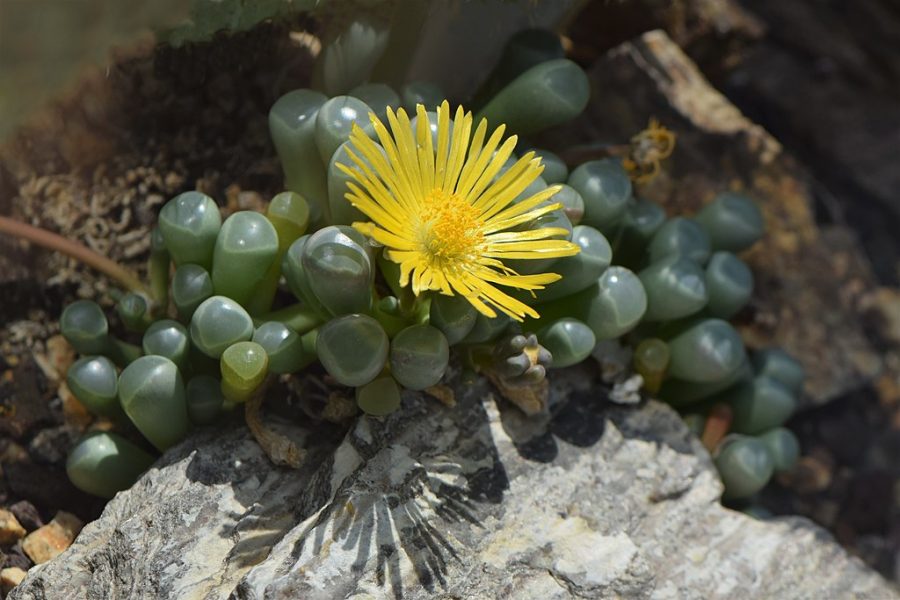This post contains affiliate links. If you buy something from one of our links we may earn a commission. Thanks

Discover the secrets to Baby Toes plant care with our comprehensive guide! Learn essential tips for light, watering, propagation, and more.
Baby Toes or Fenestraria plants require well-draining soil and a sunny location for optimal growth. These succulents need minimal watering; let the soil dry out between waterings. They are sensitive to overwatering, which can lead to root rot. Fertilize sparingly during the growing season for best results.
Are you fascinated by the adorable and unique Baby Toes plant? Well, you’re in luck!
In this comprehensive guide, we’ll dive into the world of Baby Toes plant care, uncovering all the essential tips and tricks to help your delightful succulent thrive.
From light and soil requirements to propagation and potential issues, we’ve got your back.
So, let’s embark on this exciting journey and transform your green thumb into a Baby Toes plant care expert!
Baby Toes Plant Care (Fenestraria rhopalophylla)
Welcome to the charming world of Baby Toes succulents, also known as Fenestraria rhopalophylla!
This captivating little succulent plant boasts a unique appearance, resembling tiny toes poking out of the soil.
As a member of the Aizoaceae family, this plant hails from South Africa. Its natural habitat is Namaqualand in southern Africa.
Baby Toes plants have some distinct care requirements that set them apart from other succulents.
Baby Toes has unique semi-transparent leaf windows on top of each of its little toes.
In this comprehensive guide, we’ll explore all the aspects of Baby Toes plant care to help you nurture a healthy, thriving plant that adds a whimsical touch to your collection. Let’s get started!
Importance of proper Baby Toes Plant Care for optimal growth
We all know that giving our green friends the right care is crucial for their overall health and happiness.
In this section, we’ll explore the importance of proper care when it comes to ensuring optimal growth for your Baby Toes succulent plants.
By following a few simple guidelines, you’ll be well on your way to nurturing a thriving, robust Baby Toes succulent that adds a touch of whimsy to your home or garden.
So, let’s dive in and learn how to keep your Baby Toes plant healthy and growing strong!
Baby Toes Succulent Light Requirements
Understanding the light requirements for your Baby Toes succulent is essential for helping it flourish.
These sun-loving plants need just the right amount of bright light to stay healthy and grow at their best.
In this section, we’ll discuss the importance of providing adequate sunlight and offer tips on how to ensure your Baby Toes plant gets the rays it needs, whether it’s basking outdoors or brightening up your indoor space.
Another common name for this plant is Window Plant because that’s the best place to keep it.
So let’s shed some light on the subject and give your baby toe succulents the best chance to thrive!
The Role of Full Sun Exposure in Baby Toes Succulents
Full sun exposure plays a vital role in the health and growth of your Baby Toes plant.
These succulents, originating from the sunny regions of Namaqualand and Namibia, are well-adapted to bask in the sun’s rays.
By providing them with enough sunlight, you’ll notice vibrant growth and better overall health.
However, be mindful of avoiding sunburn by gradually increasing their sun exposure, especially if they’re new to your collection or have been in a shaded area for some time.
Daily Sunlight Requirements for Baby Toes Plants
Your Fenestraria Baby Toes succulent will thrive when it receives around 4 to 6 hours of sunlight per day.
The more sunlight they get, the better they’ll grow, but always be cautious about exposing them to harsh, direct sunlight for extended periods, as it can cause sunburn.
Ideally, try to give your plant a combination of direct and bright indirect light to ensure it gets the right amount of sun without any harm.
Bringing the Sun Indoors: Tips for Adequate Indoor Lighting
If you’re growing your Baby Toes succulent indoors, providing enough sunlight might seem a bit challenging.
But don’t worry, with a few simple tricks, you can keep your plant happy and healthy.
Here are some tips to help you out:
• Place your plant near a sunny windowsill: A south-facing window is perfect for Baby Toes succulents, as they receive ample sunlight throughout the day.
East or west-facing windows can also work well, especially if they get plenty of morning or afternoon sun.
• Rotate your plant: To ensure even growth, rotate your Baby Toes plant every few weeks.
This will prevent it from leaning or becoming lopsided as it reaches for the sunlight.
• Use artificial lighting: If your home doesn’t receive enough natural light, consider using a grow light to supplement your plant’s lighting needs.
LED grow lights are energy-efficient and can provide the right spectrum of light to promote healthy growth in your Baby Toes succulent.
Baby Toes Succulent Soil Composition
Getting the soil composition right is crucial for the well-being of your Baby Toes succulent.
These little plants have specific preferences when it comes to their growing medium, and finding the perfect blend will set them up for success.
In this section, we’ll dig into the ideal soil mixture for Baby Toes plants, focusing on the benefits of using coco coir and perlite.
Regular potting soil is really too heavy and will hold on to excess water and stay wet too long. If you must use it be sure to add extra perlite to it.
So, let’s roll up our sleeves and prepare the perfect foundation for your Baby Toes succulent to thrive in!
The Perfect Blend: Coco Coir and Perlite
When it comes to the ideal soil mixture for your Baby Toes succulent, a blend of coco coir and perlite is a winning combination.
These plants prefer well-draining soil that retains some moisture without becoming soggy.
A 1:1 ratio of coco coir and perlite creates a loose, airy mix that allows water to drain effectively while still providing the right amount of moisture for your plant.
Advantages of Using Coco Coir and Perlite
This soil mix offers numerous benefits for your Baby Toes plant:
• Improved aeration: The combination of coco coir and perlite promotes excellent aeration, preventing the roots from becoming compacted and ensuring they receive enough oxygen.
• Enhanced drainage: A well-draining soil mix is crucial for Baby Toes plants, as it helps prevent root rot and other issues related to overwatering.
The perlite in the mix aids in drainage, reducing the chances of waterlogged soil.
Coco coir outperforms peat moss and is a more environmentally friendly option.
• Moisture retention: Coco coir retains moisture without becoming overly saturated, providing a consistent level of dampness that Baby Toes succulents appreciate.
Preparing the Perfect Soil for Your Baby Toes Succulent
To create the ideal growing medium for your Baby Toes plant, follow these steps:
• Mix equal parts of coco coir and perlite in a bowl or container. You can adjust the ratio slightly if you live in an area with high humidity or if your plant requires more drainage.
• Moisten the soil mix with water until it’s damp but not soaking wet.
• Fill your chosen pot with the prepared soil mixture, leaving enough room for your Baby Toes plant to be planted at the same depth it was in its previous container.
• Gently place the plant in the soil and firm the mixture around the roots, making sure the plant is well-anchored.
• To maintain the soil, make sure you let it dry out completely between waterings, and avoid overwatering your Baby Toes plant.
• Additionally, consider refreshing the soil mix every couple of years or when repotting to ensure it continues providing the best environment for your plant.
Baby Toes Succulent Watering Techniques
Mastering the art of watering your Baby Toes succulent is key to helping it flourish.
These unique plants often grow under drought conditions and have particular hydration needs that differ from other succulents, and understanding how to quench their thirst without overdoing it is essential.
In this section, we’ll dive into the best watering techniques for Baby Toes plants, covering everything from frequency to avoiding common pitfalls.
Let’s get ready to quench your plant’s thirst the right way and set it on the path to healthy, vibrant growth!
Watering Frequency: Active Growing vs. Dormant Periods
Understanding the watering needs of your Baby Toes plant during its active growth and dormant periods is crucial for keeping it healthy.
Make sure any pot you use has a drainage hole. Here’s a breakdown of how often you should water your plant during these phases:
Active growing period: During fall, winter, and spring, when your Baby Toes succulent is actively growing, water it thoroughly once the soil has completely dried out.
This can be approximately every 10 to 14 days, but always check the soil’s moisture level before watering.
Dormant period: In the summer months, when the plant is dormant, reduce the watering frequency to once every 3 to 4 weeks.
This will prevent overwatering and allow the plant to rest.
Recognizing Overwatering and Underwatering
Being able to identify signs of overwatering and underwatering is essential to ensure your Baby Toes plant’s well-being.
Here are some symptoms to look out for:
Overwatering: Mushy, yellowing leaves, root rot, and a soft, weak stem are common signs of overwatering. If not addressed giving too much water can lead to overwatering and the death of your plant.
Underwatering: Wrinkled, shriveled leaves, slow growth, and drooping are symptoms of underwatering. If your Baby Toes plant shows these signs, it’s time to give it a drink.
Proper Watering Tips to Avoid Root Rot
Follow these tips to water your Baby Toes succulent correctly and prevent root rot:
Use the “soak and dry” method: Water your plant thoroughly until water drains out of the bottom of the pot, then allow the soil to dry out completely before watering again.
Avoid waterlogged soil: Ensure your pot has drainage holes and that the soil mix drains well to prevent water from accumulating around the roots.
Check for moisture: Before watering, poke your finger an inch or two into the soil to make sure it’s dry. If it still feels damp, wait a few more days before checking again.
Be mindful of temperature and humidity: Adjust your watering frequency based on the environment your plant is in, as higher humidity and cooler temperatures can cause the soil to retain moisture for longer periods.
Baby Toes Succulent Temperature Preferences
Just like us, Baby Toes succulents have their own temperature preferences, and finding the sweet spot for these quirky plants is key to helping them thrive.
In this section, we’ll discuss the ideal temperature range for Baby Toes plants and share some tips on how to keep your plant cozy during both warm and cool months.
So, let’s dive in and explore the world of Baby Toes succulent temperature preferences, ensuring your plant stays comfortable and content all year round!
Finding the Sweet Spot: Ideal Temperature Range for Healthy Growth
Baby Toes succulents thrive in temperatures ranging from 65 to 80°F (18 to 27°C) during the day and around 50 to 55°F (10 to 13°C) at night.
Keeping your plant within this temperature range will promote healthy growth and prevent stress-related issues.
Maintaining Temperature in Different Environments
Here are some tips to help you maintain the ideal temperature for your Baby Toes succulent in various settings:
Indoors: Place your plant in a room with stable temperatures, avoiding drafty areas or spots near heating or cooling vents.
You may also want to use a small fan to improve air circulation around the plant if the room is stuffy.
Outdoors: If you’re growing your Baby Toes plant outside, make sure it’s in a location that provides some shade during the hottest part of the day.
Be prepared to move it indoors or provide protection if temperatures drop below 50°F (10°C) or soar above 80°F (27°C).
Recognizing Temperature Stress and Remedying the Situation
Temperature stress can negatively affect your Baby Toes plant.
Here are some signs to look out for and steps to remedy the situation:
Signs of heat stress: Wilting, sunburn (brown or black spots on the leaves), and a color change to a pinkish hue may indicate heat stress.
Move the plant to a shadier spot, provide filtered sunlight, or bring it indoors during extreme heat.
Signs of cold stress: Discoloration, softening leaves, and leaf drop could signal that your plant is too cold.
Move it to a warmer location, provide insulation with a frost cloth, or bring it indoors if temperatures drop too low.
By monitoring and adjusting your Baby Toes plant’s environment, you can maintain the ideal temperature and keep your succulent happy and healthy.
Baby Toes dormant season
Baby Toes succulents (Fenestraria rhopalophylla) have an active growing season during the fall, winter, and spring months.
During this time, they focus on growth, producing new leaves and, in some cases, flowers.
It is essential to provide them with proper care during this active growing period, which includes adequate sunlight, appropriate watering, and well-draining soil.
In contrast, Baby Toes succulents enter a dormant period during the late summer months.
During dormancy, their growth slows down, and they require less water than during the active growing season.
It is crucial to adjust your care routine accordingly to ensure your Baby Toes succulents remain healthy and vibrant throughout the year.
By understanding the natural growing cycle of your Baby Toes succulents, you can provide them with the care they need to thrive and enjoy their charming appearance in your plant collection.
Because they have a different growing season and go dormant during the winter months it is important to maintain warm temperatures if you have cold winters so they can rejuvenate themselves and get ready for early spring again.
Baby Toes Flowers
Baby Toes succulents (Fenestraria rhopalophylla) are not only known for their unique and adorable leaf appearance but also for their beautiful yellow flowers.
These succulents produce charming daisy-like flowers that are typically yellow in color, although some subspecies may have slightly different shades.
The flowers usually bloom during the fall and winter months, adding a pop of color to your plant collection during the colder seasons.
To encourage your Baby Toes plant to bloom, be sure to provide optimal care, including sufficient sunlight, proper watering, and the right soil mix.
When the plant is happy and healthy, it’s more likely to reward you with its charming blossoms.
Remember that Baby Toes succulents have a dormant period during the summer months, so don’t be concerned if you don’t see any flowers during that time.
With patience and proper care, you’ll likely see those lovely blooms brightening up your space in the cooler months.
Baby Toes Succulent Propagation Methods
Sharing the love of Baby Toes succulents with friends and family is easier than you might think, thanks to the plant’s propagation abilities.
In this section, we’ll explore various methods for propagating your Baby Toes plant and walk you through the steps to create new little plants from your existing one.
So, let’s get ready to multiply your Baby Toes family and spread the joy of these adorable succulents with those around you!
Propagation Techniques: Leaf and Offset Methods
There are two primary methods for propagating your Baby Toes succulent: leaf and offset propagation. Here’s a brief overview of each technique:
Leaf propagation: Involves removing a healthy leaf from the mother plant, allowing it to callus, and then placing it on well-draining soil to encourage root development.
Offset propagation: Requires separating offsets or small clusters of Baby Toes from the mother plant and planting them in their own pots.
Step-by-Step Guide for Successful Propagation
Here’s a step-by-step guide to propagating your Baby Toes succulent using both methods:
• Choose a healthy leaf or offset: Select a robust, plump leaf or offset from the mother plant.
Make sure it’s free of any signs of disease or damage.
• Remove the leaf or offset: For leaf propagation, gently twist the leaf off the stem, ensuring a clean break.
For offset propagation, use a sterile knife or scissors to separate the offset from the mother plant, making a clean cut at the base.
• Allow to callus: Set the removed leaf or offset aside for a few days to allow the cut end to form a callus.
This step is can help to prevent rot when placed in soil.
• Prepare the soil: Fill a small pot with a well-draining soil mix, such as a blend of coco coir and perlite.
• Plant the leaf or offset: For leaf propagation, lay the callused leaf on the soil surface, making sure the cut end makes contact with the soil.
For offset propagation, plant the callused offset in the soil, with the base buried just beneath the surface.
• Provide care: Place the pot in a bright, indirect light location and maintain a consistent temperature.
Do not water the leaf or offset for the first week. After the first week, mist the soil lightly every few days to keep it slightly damp.
Tips for Encouraging New Growth
Follow these tips to increase your chances of successful propagation and encourage new growth:
• Be patient: Propagation can take time, so don’t be discouraged if you don’t see immediate results. Roots and new growth may take a few weeks to appear.
• Monitor moisture levels: Keep the soil slightly damp but not wet, as overwatering can cause rot and hinder the propagation process.
• Provide adequate light: Bright, indirect light is crucial for successful propagation.
Ensure your new Baby Toes plants receive enough light, but avoid direct sunlight to prevent scorching.
• Gradually acclimate to normal care: Once you see new growth and roots have developed, slowly transition your Baby Toes plant to its regular care routine, including watering frequency and light exposure.
Baby Toes Succulent Turning Pink: Causes and Solutions
Has your Baby Toes succulent taken on a pinkish hue, leaving you puzzled about what’s happening?
In this section, we’ll explore the reasons behind your plant’s color change and share some solutions to help your Baby Toes return to their usual vibrant green.
So, let’s dive into the world of pink Baby Toes succulents and learn how to keep your plant looking its best, no matter the circumstances!
Unraveling the Mystery: Reasons for Color Change, Including Sun Stress
Several factors can cause your Baby Toes succulent to turn pink.
Let’s take a look at the most common reasons:
Sun stress: Prolonged exposure to direct sunlight or intense heat can cause your Baby Toes plant to develop a pink hue as a protective response.
Cold stress: Similarly, exposure to cold temperatures can trigger a color change in your plant.
Natural pigmentation: Some Baby Toes succulents have a natural tendency to develop a pinkish color under certain conditions or during specific growth stages.
Addressing and Preventing Pink Coloration
To help your Baby Toes plant to return to its original color and prevent further pink coloration, follow these tips:
Adjust light exposure: If your plant is exposed to intense sunlight, move it to a location with bright, indirect light, or provide it with some shade during the hottest part of the day.
Monitor temperatures: Keep your plant within the ideal temperature range of 65 to 80°F (18 to 27°C) during the day and 50 to 55°F (10 to 13°C) at night to avoid temperature stress.
Gradual acclimatization: If you need to move your plant to a new location, do so gradually to help it acclimate to the new light and temperature conditions.
When to Be Concerned About Color Changes
While a pink hue can be normal in some cases, there are instances when a color change might signal a problem:
Other signs of stress: If your plant exhibits additional symptoms such as wilting, yellowing leaves, or poor growth, it may be experiencing stress beyond just a color change.
Disease or pests: If you notice signs of disease or pests, such as spots, discoloration, or insect infestations, take immediate action to treat the issue.
By understanding the causes behind your Baby Toes succulent’s color change and taking appropriate action, you can help your plant maintain its health and vibrancy.
Common Baby Toes Succulent Problems and Solutions
Even though Baby Toes succulents are relatively low-maintenance, they can still encounter a few bumps in the road.
In this section, we’ll discuss some common problems that may arise while caring for your Baby Toes plant and provide solutions to help your plant overcome these challenges.
Armed with this knowledge, you’ll be better prepared to tackle any issues that come your way, ensuring your Baby Toes succulent remains happy, healthy, and thriving!
Detective Work: Identifying Issues Such as Pests, Diseases, and Environmental Stressors
Keeping an eye out for common Baby Toes succulent problems is essential to maintaining a healthy plant.
Here are some issues to watch for:
Pests: Look for signs of mealybugs, aphids, or spider mites, which may appear as tiny insects, webbing, or sticky residue on your plant.
Diseases: Fungal and bacterial diseases can manifest as black or brown spots, mushy leaves, or a foul smell. Root rot is another common issue, often caused by overwatering.
Environmental stressors: Wilting, yellowing, or dropping leaves, as well as color changes, can indicate that your plant is experiencing stress from factors such as inadequate light, extreme temperatures, or improper watering.
Problem-Solving: How to Address and Prevent These Problems
Tackling Baby Toes succulent problems requires a combination of prompt action and preventive measures:
Combat pests: Remove visible pests with a cotton swab dipped in rubbing alcohol, and treat your plant with a natural insecticidal soap or horticultural oil to prevent future infestations.
Treat diseases: Prune away affected areas using sterile tools and adjust your plant’s care to create a healthier environment.
For example, reduce watering if you suspect root rot and improve air circulation to prevent fungal diseases.
Minimize stress: Ensure your plant receives the proper amount of light, maintains a consistent temperature, and follows a suitable watering schedule to minimize stress.
Cultivating Wellness: Tips for Maintaining Overall Plant Health
By following these tips, you can promote overall health and prevent many common problems:
Use well-draining soil: A blend of coco coir and perlite will help prevent overwatering and root rot.
Water appropriately: Allow the soil to dry out between waterings, and adjust your watering frequency based on the season and your plant’s growth stage.
Monitor light and temperature: Provide your Baby Toes succulent with the right amount of light and maintain the ideal temperature range to promote healthy growth.
Inspect your plant regularly: Regularly check your plant for signs of pests, diseases, or other issues, and address problems promptly to prevent them from escalating.
By staying vigilant and following these tips, you can help ensure your Baby Toes succulent remains healthy and problem-free.
Baby Toes Succulent Dying: Signs and Rescue Tips
It’s disheartening to see your beloved Baby Toes succulent showing signs of decline, but don’t lose hope just yet!
In this section, we’ll discuss the telltale signs that your plant may be dying and share some rescue tips to give it a fighting chance at recovery.
With a little love, care, and attention, you might be able to turn things around and nurse your Baby Toes succulent back to health.
So, let’s dive in and learn how to save your struggling plant from the brink!
Early Warning System: Recognizing Early Signs of a Dying Plant
Spotting the early signs of a dying Baby Toes succulent can make all the difference in its chances of recovery.
Keep an eye out for these indicators:
• Wilting or yellowing leaves: These could be a sign of overwatering or underwatering.
• Soft, mushy leaves: This may indicate root rot or fungal infection.
• Shrinking or wrinkling leaves: A lack of water or nutrients might be causing these symptoms.
• Spots, discoloration, or abnormal growth: These could be signs of pest infestations or diseases.
Plant Resuscitation: Steps to Revive a Struggling Baby Toes Succulent
If your Baby Toes plant shows signs of distress, take these steps to help it bounce back:
Assess the situation: Determine the cause of your plant’s decline, such as pests, diseases, or improper care.
Address the issue: Depending on the problem, take appropriate action, such as removing pests, pruning diseased areas, adjusting watering habits, or changing the plant’s environment.
Repot if necessary: If root rot is present, remove the affected roots, let the healthy roots dry out, and repot your plant in fresh, well-draining soil.
Provide optimal care: Ensure your plant receives proper light, temperature, and watering to support its recovery.
Know When to Let Go: When to Give Up on a Dying Plant
Unfortunately, not all plants can be saved. It’s important to recognize when it’s time to let go of a dying Baby Toes succulent:
Severe root rot: If the majority of your plant’s roots are affected, it may be beyond rescue.
Extensive damage: If pests or diseases have caused significant damage to the plant’s leaves and stems, it might not be able to recover.
No signs of improvement: If your plant shows no improvement despite your best efforts, it may be time to accept the loss and start anew.
While it’s hard to say goodbye to a dying plant, the experience can be a valuable lesson in plant care, helping you become a better caretaker for your future Baby Toes succulents.
Baby Toes Succulent Toxicity: Are They Safe for Cats?
As a plant lover, you might also be a proud cat owner, and it’s essential to keep your feline friends safe from potential hazards.
In this section, we’ll explore the toxicity of Baby Toes succulents and whether they pose a threat to your curious kitties.
Understanding the safety of your plants can help create a harmonious environment where both your Baby Toes and your feline family members can thrive.
So, let’s delve into the topic of Baby Toes succulent toxicity and how it affects our furry companions!
Toxicity Report: Toxicity Level for Cats
When it comes to Baby Toes succulents, you can breathe a sigh of relief. These charming plants are generally considered non-toxic to cats.
However, it’s always a good idea to prevent your pets from chewing on plants, as individual sensitivities or excessive consumption can still cause mild digestive upset.
Ingestion Watch: Symptoms of Ingestion in Pets
Though Baby Toes succulents aren’t considered toxic to cats, it’s essential to be aware of the signs that may indicate your pet has ingested a plant:
Vomiting
Diarrhea
Drooling
Loss of appetite
Lethargy
If you notice any of these symptoms after your cat has nibbled on a Baby Toes succulent or any other plant, it’s a good idea to contact your veterinarian for advice.
Safe Haven: Tips for Keeping Baby Toes Succulents and Pets Safe
Even though Baby Toes succulents are not toxic to cats, it’s wise to take precautions to keep both your plants and pets safe:
• Place plants out of reach: Elevate your Baby Toes succulents on shelves or hang them in locations where your cat can’t access them.
• Distract your cat: Provide your feline friend with designated cat-safe plants or toys to chew on and play with, diverting their attention away from your Baby Toes succulents.
• Supervise interactions: Keep an eye on your cat when they’re near your plants, and gently discourage them from chewing on the leaves.
By following these tips, you can create a safe and harmonious environment for both your Baby Toes succulents and your beloved feline companions.
Baby Toes (Fenestraria) FAQs
Baby Toes, or Fenestraria plants, are interesting succulents that captivate with their unique appearance.
Caring for these small wonders involves understanding their needs for light, water, and soil conditions.
While they may look fragile, they’re actually fairly easy to take care of with the right attention.
Below are some frequently asked questions to guide you through the process of caring for Baby Toes plants.
Q: How do you take care of Baby Toes?
A: Baby Toes require well-draining soil, moderate to bright light, and minimal watering. Make sure the soil dries out between waterings to avoid root rot.
Q: Do Baby Toes need full sun?
A: Baby Toes prefer bright, indirect light rather than full sun. Direct sunlight can scorch their leaves, so it’s good to provide some shade.
Q: How much light do Baby Toes need?
A: These plants thrive in moderate to bright light conditions. If you’re growing them indoors, place them near a south or west-facing window but out of direct sunlight.
Q: How often should you water Baby Toes?
A: Watering should be minimal. Wait until the soil is completely dry before watering again. Overwatering can lead to root rot, a common problem for these plants.
Baby Toes Plant Care Final Thoughts
As we wrap up our comprehensive guide on Baby Toes plant care, we hope you feel more confident in caring for these adorable succulents.
With their unique appearance and fascinating growth habits, Baby Toes are truly a delightful addition to any plant collection.
By following our tips and advice, you’ll be well-equipped to provide your Baby Toes succulents with the optimal conditions they need to thrive.
So, go forth and enjoy the rewarding journey of nurturing these delightful plants, and watch as they grow and flourish under your loving care!
Care Essentials Recap: Key Points for Baby Toes Plant Care
Let’s take a moment to review the essential aspects of Baby Toes plant care that we’ve covered in this guide:
• Light requirements: Full sun exposure for optimal growth.
• Soil composition: A well-draining mix of coco coir and perlite.
• Watering techniques: Infrequent watering, adjusting for active growth and dormant periods.
• Temperature preferences: Maintaining the ideal temperature range for healthy growth.
• Propagation methods: Leaf and offset propagation techniques for expanding your collection.
• Troubleshooting: Identifying and addressing common issues, including color changes and plant problems.
The Benefits of Proper Care – A Thriving, Beautiful Succulent
By mastering the art of Baby Toes plant care, you’ll be rewarded with a thriving, beautiful succulent that adds a unique touch to your home or garden.
These fascinating plants, with their transparent window-like tips and charming appearance, are sure to be a conversation starter and a source of joy for any plant enthusiast.
By providing the proper care, you’ll not only ensure the health and happiness of your Baby Toes succulent but also deepen your connection to the incredible world of plants.
Read more: 10 Benefits Of Succulent Plants Indoors [Plus They’re Easy To Grow]






















